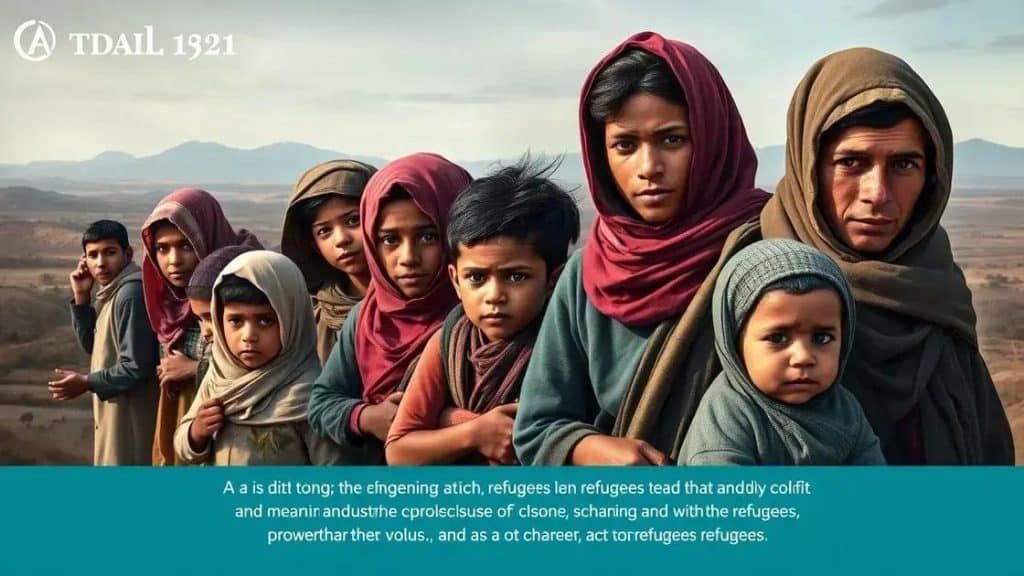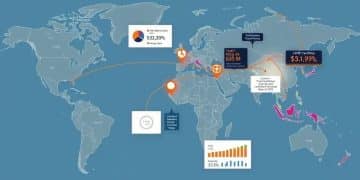Updates on global refugee crises: what you need to know

Anúncios
Updates on global refugee crises reveal the urgent need for support, as millions are displaced by conflict and climate change, highlighting the vital role of international organizations in providing aid and fostering empathy.
Updates on global refugee crises shed light on the complexities of forced migration today. With millions affected, it prompts us to consider how we can engage and support those in need.
Anúncios
Current state of global refugee crises
The current state of global refugee crises is alarming. Millions are fleeing their homes due to wars, persecution, and natural disasters. It’s crucial to understand what’s happening and how it affects us all.
Statistics on Displacement
According to the UNHCR, over 26 million people are currently classified as refugees. These individuals often face long journeys and treacherous conditions. Many look for safety and a chance for a better life.
Anúncios
- Top countries hosting refugees include Turkey, Colombia, and Pakistan.
- More than half of the world’s refugees are from just three countries: Syria, Afghanistan, and South Sudan.
- The global refugee population has doubled in the last decade.
Additionally, the number of internally displaced persons (IDPs)—those forced to flee within their own countries—now exceeds 50 million. This creates significant challenges for governments and international organizations trying to provide aid.
Challenges Faced by Refugees
Refugees face numerous hurdles when they arrive in host nations. Many confront language barriers, legal obstacles, and cultural differences. It can be difficult for them to find jobs or access education, which are essential for rebuilding their lives.
In many cases, refugees experience trauma from violence and loss, making their journey even harder. Support from the global community is needed to help them heal and integrate into new societies.
Organizations like the UNHCR and NGOs work tirelessly to address these needs. They provide food, shelter, and medical assistance to affected families. Awareness and action are vital as the crises continue to evolve.
Impact of climate change on displacement

The impact of climate change on displacement is becoming increasingly evident. As natural disasters become more frequent, more people are forced to leave their homes. This creates a growing population of displaced persons.
Increasing Natural Disasters
Severe weather events, such as hurricanes, floods, and droughts, have intensified due to climate change. These disasters destroy homes, farmland, and infrastructure, urging families to seek safety elsewhere.
- Many coastal communities are at risk from rising sea levels.
- Extreme heat can lead to crop failures, pushing farmers to migrate.
- Climate refugees face urgent needs, such as food, water, and shelter.
It’s not just extreme weather that drives displacement; gradual changes like desertification also play a critical role. As land becomes uninhabitable, people are left with no choice but to relocate.
Long-term Consequences
Climate change can lead to long-term displacement, affecting millions. When people leave their homes permanently, the social, economic, and political challenges multiply.
Governments and organizations must create policies that address the links between climate change and migration. Preventative measures, such as improving infrastructure, can help communities adapt and stay resilient.
Furthermore, awareness and education on climate impacts are crucial for communities worldwide. By understanding these issues, we can work together to find sustainable solutions that protect vulnerable populations.
Role of international organizations in aid
The role of international organizations in aid is crucial in addressing the needs of refugees and displaced persons. These organizations work tirelessly to provide support and resources to those who have been affected by crises.
Key Organizations Involved
Several prominent international organizations play significant roles in delivering humanitarian aid. They are often the first responders during emergencies, providing essential services.
- The UNHCR focuses on protecting the rights of refugees.
- The Red Cross offers medical assistance and disaster relief.
- International NGOs often bridge gaps in service delivery, working locally.
These organizations not only deliver aid but also advocate for policies that protect vulnerable populations. Their influence can lead to changes in governmental strategies and international cooperation.
Types of Aid Provided
International organizations provide various kinds of assistance to refugees. This includes food, shelter, and medical care. They also help with long-term support like education and job training.
The focus is often on creating sustainable solutions that empower refugees. For example, programs may include skill development or psychological support, enabling individuals to rebuild their lives.
Partnerships between countries and international organizations also enhance the effectiveness of aid. Collaborative efforts ensure that resources are used efficiently, maximizing positive outcomes for communities in need.
Personal stories from refugees around the world

Personal stories from refugees around the world offer deep insights into their struggles and resilience. Each tale reflects the unique challenges faced by individuals and families forced to flee their homes.
Voices of Hope
Many refugees share stories of hope and determination. For instance, a young woman from Syria recounted her journey across borders in search of safety. Despite the hardships, she remained hopeful about a better future.
- A man from Afghanistan spoke of leaving everything behind to protect his family from conflict.
- Some mothers describe the fear of raising children in camps while yearning for stability.
- Others tell of friendships formed with fellow refugees that inspire strength and solidarity.
These narratives often highlight the humanity behind the statistics. They show that refugees are not just numbers but individuals with dreams, fears, and aspirations.
Every Story Counts
Every refugee’s journey is different but shares common themes of loss and resilience. Many face language barriers and cultural adjustments as they settle into new communities. These challenges can be daunting.
However, many find support through local organizations and volunteers. Community members often help refugees integrate, offering language lessons and cultural resources.
Sharing personal stories can foster empathy and understanding among those who may not know the reality of life as a refugee. By listening to their experiences, we can build a more compassionate world.
FAQ – Frequently Asked Questions About Refugees
What are the main reasons people become refugees?
People become refugees due to various reasons, including war, persecution, and natural disasters that force them to flee their homes.
How do international organizations support refugees?
International organizations provide essential aid such as food, shelter, medical care, and help refugees with integration into new communities.
What challenges do refugees face when displaced?
Refugees often face challenges like language barriers, legal obstacles, cultural adjustments, and trauma from their experiences.
How can individuals help refugees in their communities?
Individuals can help by volunteering, donating to local organizations, or advocating for policies that support refugee rights and assistance.





